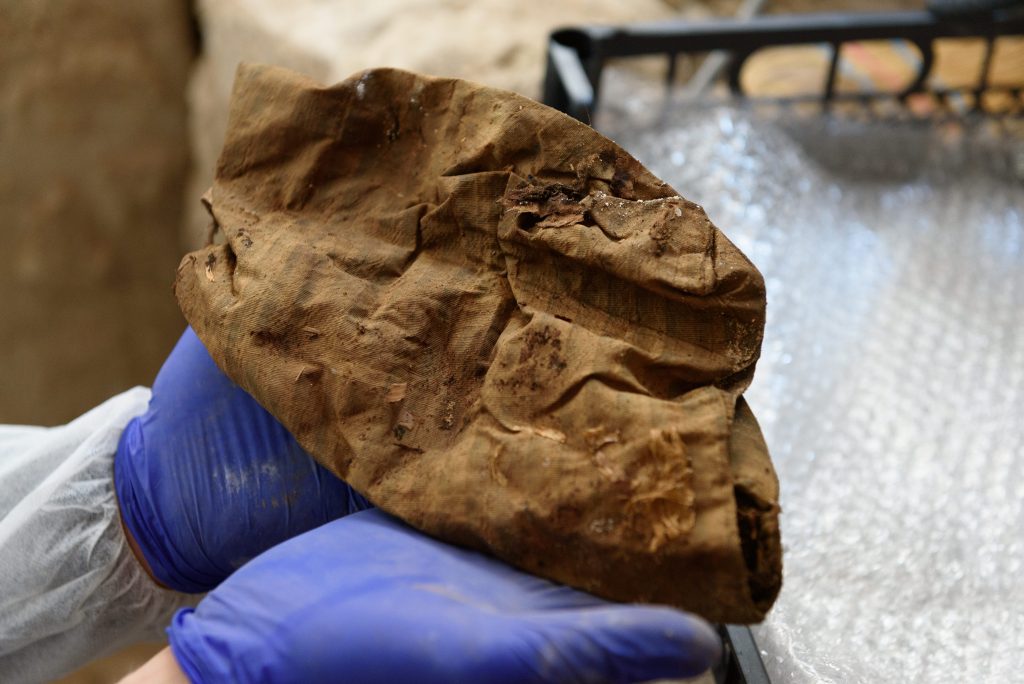Archaeologists continue the exploration of the newly opened crypt in the Reformed Church of Bánffyhunyad, which holds the remains and funeral objects of people who lived at least three centuries before our time. As we reported last week, the leader of the team of archaeologists and restorers from the National History Museum of Transylvania, Zsolt Csók, has found an intact crypt in the church, which is in the process of being restored. On the 30th of September, he unearthed and opened the first coffin, which contained the remains of a little girl who was at most three or four years old. She wore a beautiful green silk dress and a brocade coronet decorated with a lace interwoven with silver thread.
The discovery of this funeral site is hugely important, as there hasn’t been such an opportunity to research an intact crypt in more than a century in Transylvania. Archaeologists are now outlining and trying out the research methodology required for this kind of exploration. It is for certain that removing the contents of the crypt is a privileged, awe-inspiring, and earth-shattering experience for the archaeologists, as they unearth more and more remains and mementos of these past lives.
The crypt was quarantined, and only those wearing protective suits and masks are allowed to enter. The team mostly fears that natural bacteria that can get into this special environment could advance the speed of degradation of the remains. On the other hand, the findings will be examined microbiologically to determine what organisms were on them when the crypt was opened. One thing is certain: The deceased did not die of the plague, as there was no whitewash found.
Last Wednesday, members of the media were allowed to visit the site. On that day, Csók continued removing the debris filling the crypt, getting closer to the other three coffins; besides the funeral box of the little girl that was already taken out on Monday, there were two adult-sized coffins and another child-sized one buried in the chamber – probably all from the 17th century. On Wednesday, Csók found the lining from the first child-coffin and the small boots of the little girl made out of silk. The lining was made out of a finely woven fabric, and it contained aromatic plants, as did the tiny boots. A middle part of a saber and a shoulder piece of armor came out of the crypt that day as well, whilst in the southwestern corner of the chamber the archaeologist found three skulls, which are certainly older than those of the deceased in the coffins. Csók also managed to get to the second coffin and saw the skull of the other child, who at first glance seemed to be wearing a cap.

Csók told TN that they had excavated near the entrance of the crypt and found that the wall of the crypt has three layers, proving that it contains burials from three different ages.
The working conditions are not easy at all, as there is 91% humidity in the crypt and this condition has to be kept until they remove and stabilize the remains. The underground chamber’s length is about 1.8–2 meters, with a width of about one meter, and the height with the filling inside was about one meter as well. The high level of humidity helped preserve the woven fabrics but severely damaged the wooden objects, so archaeologists will take only parts of the bottom of the coffins and the parts studded with silver pieces for examination. As we have mentioned, the girl’s coffin bore the inscription Bánffy K., which is a clear hint that she was a member of the well-known aristocratic family, the Bánffys.
The team currently continues to explore the crypt and carefully remove its contents. The latest findings will be soon announced at a press conference, so our story will be continued when that happens. Additionally, as we have found out, there is another underground chamber next to this one, so this excavation will surely provide more findings.
Title image: Archaeologists mostly fear that today’s bacteria might speed up the degradation process
Photo: Gábor Kiss